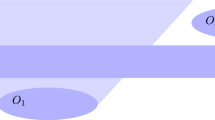Abstract
This note addresses a problem of nineteenth century applied mathematics—is it possible in the context of Hamiltonian mechanics to define a functionS of the generalized coordinates and momenta which is monotonically increasing along orbits? The question is of interest, because, for a sytem not in thermodynamic equilibrium, entropy should increase strictly monotonically along an orbit, and a negative answer implies that mechanical principles different from those of Hamiltonian mechanics must be introduced to explain thermodynamics. This note answers the question rigorously for Hamiltonian systems confined to an invariant region of finite volume in phase space; it is not possible to define a continuous function which increases monotonically along orbits. An appendix gives a translation of an 1889 paper of Poincaré addressing the same issue.
Similar content being viewed by others
References
C. Carathéodory, “Über den Wiederkehrsatz von Poincaré,”Sitzungsber. Preus. Akad. Wiss. Math.-Phys. Kl. 580-584 (1919).
P. V. Coveney, “The second law of thermodynamics: Entropy, irreversibility and dynamics,”Nature 333, 409–415 (1988).
H. von Helmholtz, “Principien der Statik monocyklischen Systeme,”J. Reine & Ang. Math. (Crelle's Journal)97, 111–140; 317-336 (1884).
H. von Helmholtz, “Über die physikalische Bedeutung des Princips der kleinsten Wirkung,”J. Reine & Ang. Math. (Crelle's Journal)100, 137–166; 213-222 (1887).
M. W. Hirsch and S. Smale,Differential Equations, Dynamical Systems and Linear Algebra (Academic, Orlando, 1974).
A. I. Khinchin,Mathematical Foundations of Statistical Mechanics, translated from Russian (Dover, New York, 1949).
C. Lanczos,The Variational Principles of Mechanics, 4th edn. (Dover, New York, 1986).
L. D. Landau and E. M. Lifshitz,Mechanics, 3rd edn., translated from Russian (Pergamon, Oxford, 1976).
B. Misra, “Nonequilibrium entropy, Lyapounov variables, and ergodic properties of classical systems,”Proc. Natl. Acad. Sci. USA 75, 1627–1631 (1978).
J. C. Oxtoby,Measure and Category, 2nd edn. (Springer, New York, 1980).
H. Poincaré, “Sur les tentatives d'explication mecanique des principes de la thermodynamique,”C. R. Acad. Sci. (Paris)108, 550–553 (1889).
I. Prigogine,From Being to Becoming: Time and Complexity in the Physical Sciences (W. H. Freeman, San Francisco, 1980).
Author information
Authors and Affiliations
Additional information
1. In the papers Poincaré cites [3,4], Helmholtz argued that a thermodynamic system undergoing reversible transformations near a minimum of the free energyU-TS is governed by equations identical to those of a “monocyclic” Hamiltonian system whose potential energy is given by the free energy. A monocyclic system is a system with several generalized coordinates, including a single cyclic one. For terminology, see, e.g., [7,8]. The cyclic coordinate is a thermodynamic variable like the temperature in Helmholtz' framework. Helmholtz was thinking about Hamiltonian systems in which the variables were relatively few phenomenological parameters, and perhaps Poincaré was, too, though with less justification, since his aim was to explore nonequilibrium phenomena, for which it is not so clear that phenomenological parameters like temperature can be defined.
2. Original title: “Sur les Tentatives d'Explication Mécanique des Principes de la Thermodynamique.” Translated into English by K. Feigl and E. T. Olsen, Department of Mathematics, Illinois Institute of Technology. Reproduced by permission of the FrenchAcademie des Sciences.
Rights and permissions
About this article
Cite this article
Olsen, E.T. Classical mechanics and entropy. Found Phys Lett 6, 327–337 (1993). https://doi.org/10.1007/BF00665652
Received:
Issue Date:
DOI: https://doi.org/10.1007/BF00665652




